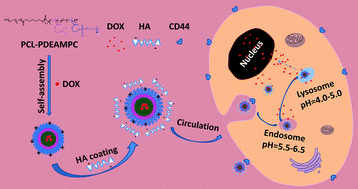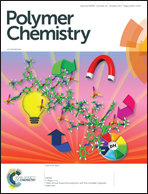Phosphorylcholine micelles decorated by hyaluronic acid for enhancing antitumor efficiency†
Abstract
Micelles with phosphatidylcholine surfaces have numerous advantages, such as good biocompatibility and high enrichment of drug in tumor tissue. In this study, we developed hyaluronic acid-coated phosphatidylcholine micelles, prepared via electrostatic attraction, for targeting the delivery of doxorubicin (DOX) to tumors. An amphiphilic copolymer poly(caprolactone)-poly(N,N-diethylaminoethyl methacrylate)-r-poly(2-(methacryloyloxy) ethyl phosphoryl choline) (PCL-PDEAMPC) was designed and synthesized successfully. PCL-PDEAMPC micelles and their DOX-loaded micelles were prepared by the dialysis method and were coated with hyaluronic acid (HA). The results showed that the micelle diameters increased a little and the zeta potential changed from positive to negative after coating with HA. The in vitro DOX release from phosphatidylcholine micelles could be triggered by pH, and the release from HA-coated PCL-PDEAMPC micelles was slower than that from PCL-PDEAMPC micelles. The in vitro cytotoxicity of the micelles was investigated using the MTT method in 4T1 cells. The results showed that the half maximal inhibitory concentration (IC50) of PCL-PDEAMPC-HA/DOX micelles was lower than that of PCL-PDEAMPC/DOX micelles. The CLSM images of cellular uptake indicated the ability of these micelles to enter into 4T1 cells. The experiments of in vivo antitumor effect and safety evaluation of DOX-loaded micelles demonstrated that the HA-coated DOX micelles had a better treatment effect and lower toxicity to 4T1-bearing Kunming mice. HA-decorated PCL-PDEAMPC micelles are therefore potential carriers for 4T1 tumor treatment.



 Please wait while we load your content...
Please wait while we load your content...